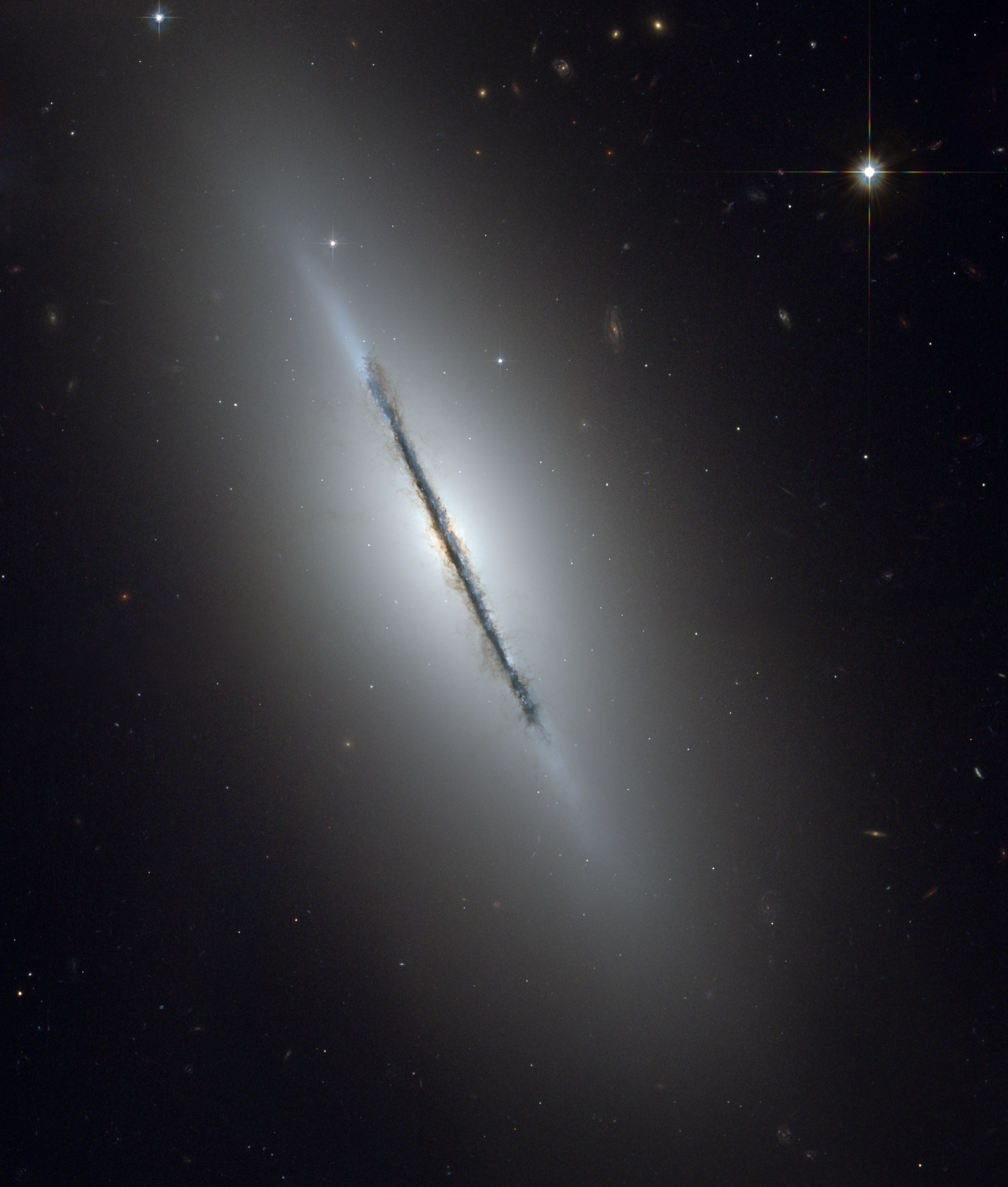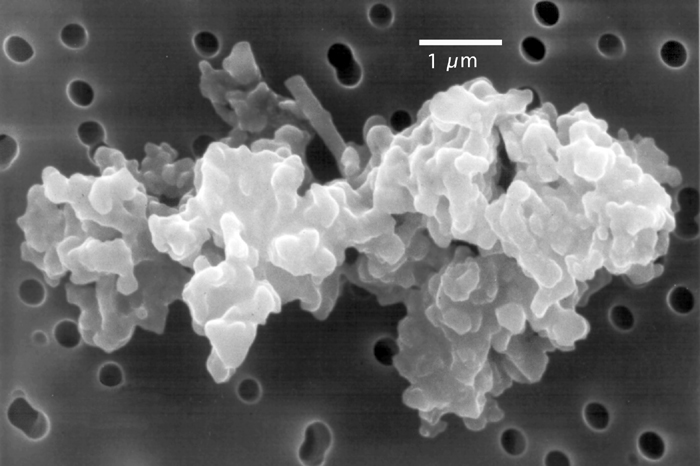|
NGC 4550
NGC 4550 is a barred spiral galaxy, barred lenticular galaxy, lenticular galaxy located in the constellation of Virgo (constellation), Virgo that can be seen with amateur astronomy, amateur telescopes. It lies at a distance of 50 million light-years (15.5 Mega-, mega parsecs) from the Milky Way and is a member of the Virgo Cluster. Physical characteristics While NGC 4550 is not one of the brightest galaxies of the Virgo Cluster, it is notable as it is one of the few galaxies where a large fraction of its stars rotate around the galaxy's center in opposite direction to the others.* About her research article on this galaxy, Vera Rubin wrote: "I discovered from observations of NGC 4550 that in the single disk of this galaxy, half the stars orbit clockwise, and half the stars orbit counterclockwise, both systems intermingled. This observation required that many astronomers modify the manner in which they measured velocities, for computer programs were not then equipped to handle ... [...More Info...] [...Related Items...] OR: [Wikipedia] [Google] [Baidu] |
New General Catalogue
The ''New General Catalogue of Nebulae and Clusters of Stars'' (abbreviated NGC) is an astronomical catalogue of deep-sky objects compiled by John Louis Emil Dreyer in 1888. The NGC contains 7,840 objects, including galaxies, star clusters and emission nebulae. Dreyer published two supplements to the NGC in 1895 and 1908, known as the ''Index Catalogues'' (abbreviated IC), describing a further 5,386 astronomical objects. Thousands of these objects are best known by their NGC or IC numbers, which remain in widespread use. The NGC expanded and consolidated the cataloguing work of William and Caroline Herschel, and John Herschel's ''General Catalogue of Nebulae and Clusters of Stars''. Objects south of the celestial equator are catalogued somewhat less thoroughly, but many were included based on observation by John Herschel or James Dunlop. The NGC contained multiple errors, but attempts to eliminate them were made by the ''Revised New General Catalogue'' (RNGC) by Jack W. Sulent ... [...More Info...] [...Related Items...] OR: [Wikipedia] [Google] [Baidu] |
Milky Way
The Milky Way is the galaxy that includes our Solar System, with the name describing the galaxy's appearance from Earth: a hazy band of light seen in the night sky formed from stars that cannot be individually distinguished by the naked eye. The term ''Milky Way'' is a translation of the Latin ', from the Greek ('), meaning "milky circle". From Earth, the Milky Way appears as a band because its disk-shaped structure is viewed from within. Galileo Galilei first resolved the band of light into individual stars with his telescope in 1610. Until the early 1920s, most astronomers thought that the Milky Way contained all the stars in the Universe. Following the 1920 Great Debate between the astronomers Harlow Shapley and Heber Curtis, observations by Edwin Hubble showed that the Milky Way is just one of many galaxies. The Milky Way is a barred spiral galaxy with an estimated D25 isophotal diameter of , but only about 1,000 light years thick at the spiral arms (more at the bulg ... [...More Info...] [...Related Items...] OR: [Wikipedia] [Google] [Baidu] |
Lenticular Galaxies
A lenticular galaxy (denoted S0) is a type of galaxy intermediate between an elliptical (denoted E) and a spiral galaxy in galaxy morphological classification schemes. It contains a large-scale disc but does not have large-scale spiral arms. Lenticular galaxies are disc galaxies that have used up or lost most of their interstellar matter and therefore have very little ongoing star formation. They may, however, retain significant dust in their disks. As a result, they consist mainly of aging stars (like elliptical galaxies). Despite the morphological differences, lenticular and elliptical galaxies share common properties like spectral features and scaling relations. Both can be considered early-type galaxies that are passively evolving, at least in the local part of the Universe. Connecting the E galaxies with the S0 galaxies are the ES galaxies with intermediate-scale discs. Morphology and structure Classification Lenticular galaxies are unique in that they have a visibl ... [...More Info...] [...Related Items...] OR: [Wikipedia] [Google] [Baidu] |
Brady Haran
Brady John Haran (born 18 June 1976) is an Australian-British independent filmmaker and video journalist who produces educational videos and documentary films for his YouTube channels, the most notable being ''Periodic Videos'' and ''Numberphile''. Haran is also the co-host of the'' Hello Internet'' podcast along with fellow educational YouTuber CGP Grey. On 22 August 2017, Haran launched his second podcast, called ''The Unmade Podcast'', and on 11 November 2018, he launched his third podcast, '' The Numberphile Podcast'', based on his mathematics-centered channel of the same name. Reporter and filmmaker Brady Haran studied journalism for a year before being hired by ''The Adelaide Advertiser''. In 2002, he moved from Australia to Nottingham, United Kingdom. In Nottingham, he worked for the BBC, began to work with film, and reported for ''East Midlands Today'', BBC News Online and BBC radio stations. In 2007, Haran worked as a filmmaker-in-residence for Nottingham Science ... [...More Info...] [...Related Items...] OR: [Wikipedia] [Google] [Baidu] |
Monthly Notices Of The Royal Astronomical Society
''Monthly Notices of the Royal Astronomical Society'' (MNRAS) is a peer-reviewed scientific journal covering research in astronomy and astrophysics. It has been in continuous existence since 1827 and publishes letters and papers reporting original research in relevant fields. Despite the name, the journal is no longer monthly, nor does it carry the notices of the Royal Astronomical Society. History The first issue of MNRAS was published on 9 February 1827 as ''Monthly Notices of the Astronomical Society of London'' and it has been in continuous publication ever since. It took its current name from the second volume, after the Astronomical Society of London became the Royal Astronomical Society (RAS). Until 1960 it carried the monthly notices of the RAS, at which time these were transferred to the newly established ''Quarterly Journal of the Royal Astronomical Society'' (1960–1996) and then to its successor journal ''Astronomy & Geophysics'' (since 1997). Until 1965, MNRAS ... [...More Info...] [...Related Items...] OR: [Wikipedia] [Google] [Baidu] |
Star Formation
Star formation is the process by which dense regions within molecular clouds in The "medium" is present further soon.-->interstellar space, sometimes referred to as "stellar nurseries" or "-forming regions", and form s. As a branch of , star formation includes the study of the |
Interstellar Dust
Cosmic dust, also called extraterrestrial dust, star dust or space dust, is dust which exists in outer space, or has fallen on Earth. Most cosmic dust particles measure between a few molecules and 0.1 mm (100 micrometers). Larger particles are called meteoroids. Cosmic dust can be further distinguished by its astronomical location: intergalactic dust, interstellar dust, interplanetary dust (such as in the zodiacal cloud) and circumplanetary dust (such as in a planetary ring). There are several methods to obtain space dust measurement. In the Solar System, interplanetary dust causes the zodiacal light. Solar System dust includes comet dust, asteroidal dust, dust from the Kuiper belt, and interstellar dust passing through the Solar System. Thousands of tons of cosmic dust are estimated to reach the Earth's surface every year, [...More Info...] [...Related Items...] OR: [Wikipedia] [Google] [Baidu] |
Disk Galaxy
A disc galaxy (or disk galaxy) is a galaxy characterized by a galactic disc, a flattened circular volume of stars. These galaxies may or may not include a central non-disc-like region (a galactic bulge). Disc galaxy types include: * Spiral galaxies: ** Unbarred spiral galaxies: (types S, SA) ** Barred spiral galaxies: (type SB) ** Intermediate spiral galaxies: (type SAB) * Lenticular galaxies: (types E8, S0, SA0, SB0, SAB0) Galaxies that are not disc types include: * Elliptical galaxies: (type dE) * Irregular galaxies: (type dI) See also * thick disk * thin disk The thin disk is a structural component of spiral and S0-type galaxies, composed of stars, gas and dust. It is the main non-centre (e.g. galactic bulge) density, of such matter. That of the Milky Way is thought to have a scale height of around ... References {{DEFAULTSORT:Disc Galaxy Galaxy morphological types ... [...More Info...] [...Related Items...] OR: [Wikipedia] [Google] [Baidu] |
Galactic Merger
Galaxy mergers can occur when two (or more) galaxies collide. They are the most violent type of galaxy interaction. The gravitational interactions between galaxies and the friction between the gas and dust have major effects on the galaxies involved. The exact effects of such mergers depend on a wide variety of parameters such as collision angles, speeds, and relative size/composition, and are currently an extremely active area of research. Galaxy mergers are important because the merger rate is a fundamental measurement of galaxy evolution. The merger rate also provides astronomers with clues about how galaxies bulked up over time. Description During the merger, stars and dark matter in each galaxy become affected by the approaching galaxy. Toward the late stages of the merger, the gravitational potential (i.e. the shape of the galaxy) begins changing so quickly that star orbits are greatly altered, and lose any trace of their prior orbit. This process is called “violent ... [...More Info...] [...Related Items...] OR: [Wikipedia] [Google] [Baidu] |
Surface Brightness
In astronomy, surface brightness (SB) quantifies the apparent brightness or flux density per unit angular area of a spatially extended object such as a galaxy or nebula, or of the night sky background. An object's surface brightness depends on its surface luminosity density, i.e., its luminosity emitted per unit surface area. In visible and infrared astronomy, surface brightness is often quoted on a magnitude scale, in magnitudes per square arcsecond (MPSAS) in a particular filter band or photometric system. Measurement of the surface brightnesses of celestial objects is called surface photometry. General description The total magnitude is a measure of the brightness of an extended object such as a nebula, cluster, galaxy or comet. It can be obtained by summing up the luminosity over the area of the object. Alternatively, a photometer can be used by applying apertures or slits of different sizes of diameter. The background light is then subtracted from the measurement to obtain t ... [...More Info...] [...Related Items...] OR: [Wikipedia] [Google] [Baidu] |
NGC 7217
NGC 7217 is an unbarred spiral galaxy in the constellation Pegasus. Features NGC 7217 is a gas-poor system whose main features are the presence of several rings of stars concentric to its nucleus: three main ones –the outermost one being of the most prominent and the one that features most of the gas and star formation of this galaxy – plus several others inside the innermost one discovered with the help of the Hubble Space Telescope; a feature that suggests NGC 7217's central regions have suffered several starbursts. There is also a very large and massive spheroid that extends beyond its disk. Other noteworthy features this galaxy has are the presence of a number of stars rotating in the opposite direction around the galaxy's center to most of them and two distinct stellar populations: one of intermediate age on its innermost regions and a younger, metal-poor version on its outermost ones. It has been suggested these features were caused by a merger with another g ... [...More Info...] [...Related Items...] OR: [Wikipedia] [Google] [Baidu] |








